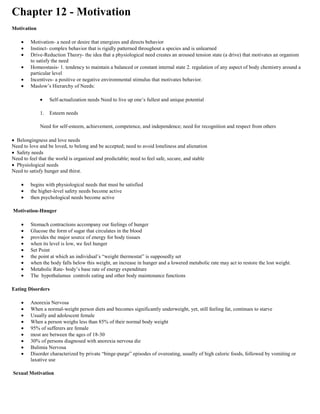
Chapter 12 motivation
- 1. Chapter 12 - Motivation<br />Motivation <br />Motivation- a need or desire that energizes and directs behavior<br />Instinct- complex behavior that is rigidly patterned throughout a species and is unlearned<br />Drive-Reduction Theory- the idea that a physiological need creates an aroused tension state (a drive) that motivates an organism to satisfy the need<br />Homeostasis- 1. tendency to maintain a balanced or constant internal state 2. regulation of any aspect of body chemistry around a particular level<br />Incentives- a positive or negative environmental stimulus that motivates behavior.<br />Maslow’s Hierarchy of Needs:<br />Self-actualization needs Need to live up one’s fullest and unique potential<br />Esteem needs<br />Need for self-esteem, achievement, competence, and independence; need for recognition and respect from others<br /> Belongingness and love needs<br />Need to love and be loved, to belong and be accepted; need to avoid loneliness and alienation<br /> Safety needs<br />Need to feel that the world is organized and predictable; need to feel safe, secure, and stable<br /> Physiological needs <br />Need to satisfy hunger and thirst.<br />begins with physiological needs that must be satisfied<br />the higher-level safety needs become active<br />then psychological needs become active<br /> Motivation-Hnuger<br />Stomach contractions accompany our feelings of hunger<br />Glucose the form of sugar that circulates in the blood<br />provides the major source of energy for body tissues<br />when its level is low, we feel hunger<br />Set Point<br />the point at which an individual’s “weight thermostat” is supposedly set<br />when the body falls below this weight, an increase in hunger and a lowered metabolic rate may act to restore the lost weight.<br />Metabolic Rate- body’s base rate of energy expenditure<br />The hypothalamus controls eating and other body maintenance functions<br />Eating Disorders<br />Anorexia Nervosa<br />When a normal-weight person diets and becomes significantly underweight, yet, still feeling fat, continues to starve<br />Usually and adolescent female<br />When a person weighs less than 85% of their normal body weight<br />95% of sufferers are female<br />most are between the ages of 18-30<br />30% of persons diagnosed with anorexia nervosa die<br />Bulimia Nervosa<br />Disorder characterized by private “binge-purge” episodes of overeating, usually of high caloric foods, followed by vomiting or laxative use<br /> Sexual Motivation<br />Sex is a physiologically based motive, like hunger, but it is more affected by learning and values<br />Sexual Response Cycle<br />The four stages of sexual responding described by Masters and Johnson<br />Excitement<br />Plateau<br />Orgasm<br />Resolution<br />Refractory Period- resting period after orgasm, during which a man cannot achieve another orgasm<br />Estrogen- a sex hormone, secreted in greater amounts by females than by males<br />Forces Affecting Sexual Motivation:<br />Imaginative stimuli<br />External stimuli<br />Physiological readiness<br />Sexual Disorders- problems that consistently impair sexual arousal or functioning<br />In Men<br />Premature ejaculation- ejaculation before they or their partners wish<br />Impotence- inability to have or maintain erection<br />In Women<br />Orgasmic disorder- infrequent or absent orgasms<br />Sexual Orientation- an enduring sexual attraction toward members of wither one’s own gender (homosexual orientation) or the other gender (heterosexual orientation)<br /> Motivation<br />Achievement Motivation- a desire for significant accomplishment<br />For mastery of things, people, or ideas<br />For attaining a high standard<br />McClelland and Atkinson believed fantasies would reflect achievement concerns<br />Intrinsic Motivation- desire to perform a behavior for its own sake or to be effective<br />Extrinsic Motivation- desire to perform a behavior due to promised rewards or threats of punishment<br />Rewards Affect Motivation<br />Controlling reward: Mom: “I’ll give you $5.00 for every A.” - <br />Extrinsic Motivation: Child: “As long as she pays, I’ll study.” <br />Informative reward: Mom: “Your grades were great! Let’s celebrate by going out for dinner.” <br />Intrinsic Motivation: Child: “I love doing well.” <br />Industrial/Organizational (I/O) Psychology- sub-field of psychology that studies and advises on workplace behavior<br />I/O Psychologists- help organizations select and train employees, boost morale and productivity, and design products and assess responses to them<br />Task Leadership- goal-oriented leadership that sets standards, organizes work, and focuses attention on goals<br />Social Leadership- group-oriented leadership that builds teamwork, mediates conflict, and offers support<br />Theory X<br />Assumes that workers are basically lazy, error-prone, and extrinsically motivated by money<br />Should be directed from above<br />Theory Y<br />Assumes that, given challenge and freedom, workers are motivated to achieve self-esteem and to demonstrate their competence and creativity<br />